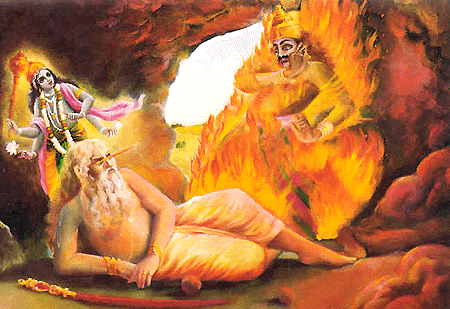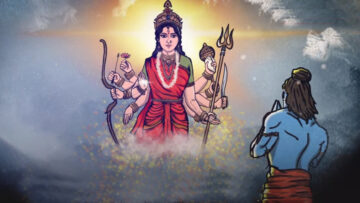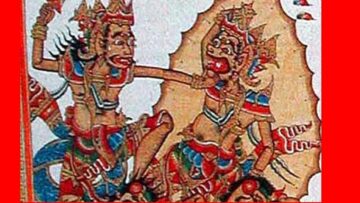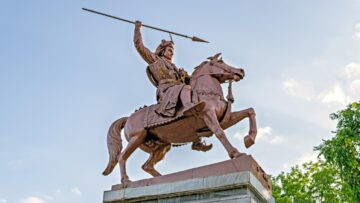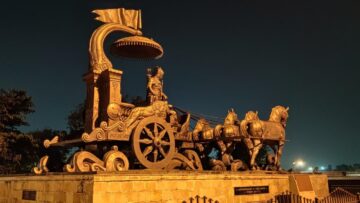This one comes from the Harivamsha. There are three mini-tales here. Two of them have to do with people, while the third has to do with a city. That the Harivamsha has less to do with Hari may also come as a surprise, but that is a tale for another time. For this one, let’s take a look at the mini-tales.
It is well-known that Krishna advocated the abandoning of Mathura and relocating the populace to the western shores, to a place called Dvaravati. He did this because of the repeated attacks on Mathura by Jarasandha – that much is also well-known. The Vrishnis agreed with Krishna and told him that Jarasandha could not be killed by them even in a hundred years. Thus, they left Mathura, and made Dvaravati their new home. Krishna did eventually get Jarasandha killed, but through the hands of Bhimasena (this story is recounted in the Jarasandha-vadha Parva of Sabha Parva).
Before I come to the interesting bit in this context about Jarasandha, let us look at the second person. He is Kalayavana, who also could not be defeated by the Yadavas. Why couldn’t he be defeated by the Vrishnis, the Andhakas? What was his story?
Like almost everything else in the Mahabharata, Kalayavana’s story also is a fascinating mix of human emotions and ego, boons, and unintended consequences. Harivamsha tells us that Gargya, the ascetic, was the guru of the Vrishnis and Andhakas. He was insulted by his brother-in-law as not being a man. This insult happened in Mathura. As a result, Gargya left the city. But now, the sage who had not taken a wife, who had not fathered a son, desired a son!
Gargya prayed to and got a boon from Rudra that he would indeed get a son, who would be capable of defeating the Vrishnis and Andhakas. Whether Gargya explicitly asked for a son with such capabilities is not told in the Harivamsha, or at least the Critical Edition of the Harivamsha. We can only speculate. Coming back to the story, the Yavana king heard of this boon that had been granted to Gargya. As circumstances would have it, the Yavana king also desired a son. He had the sage brought to his capital. Among the women that the king had, one was an apsara named Gopali, who lived there with the other gopas in the form of a human. She was the one who bore Gargya’s child. The child was brought up by the king, and ascended the throne after the Yavana king’s death. His name was Kalayavana. Now a king, he advanced towards Mathura. Madhusudana told the residents of Mathura that their time in that city was over, and that it was time to abandon the city.
But here comes an interesting twist in the tale. Krishna still wanted to test Kalayavana’s mettle, and perhaps even indulge in some psychological warfare. Whether Kalayavana was strong enough for the Vrishnis to not want to face him in battle was one thing, but what if Kalayavana lacked the temperament and the intelligence to win such a battle? Krishna wanted to test this. He had a pot with a black serpent sent to Kalayavana, signifying that Krishna was like the black serpent. How did Kalayavana respond? Killing the serpent or the messenger, or not responding would have signified a lack of intelligence or skill. After all, the question that Krishna had posed had to be answered in the same language. This test was one of intelligence, not might. Kalayavana had the pot filled with ants. The ants bit the serpent all over. The message was clear – if Krishna believed himself to be as dangerous as a serpent, Kalayavana was like the ants, who would destroy the serpent. Krishna got the message. This was an enemy that could not be defeated on the battlefield.
The decision to abandon Mathura was now beyond debate.
Kalayavana, however, did meet his end in an encounter with Krishna, though not at Krishna’s hands. After moving his people from Mathura to Dvaravati, Krishna returned to Mathura. Kalayavana set off in pursuit of Madhusudana. Krishna took Kalayavana to Muchkunda’s cave. Muchkunda was a king, who had assisted the gods in their battles against the asuras, and in gratitude got a boon from the gods that anyone disturbing his sleep would be burned to ashes from the “flames of rage” in his eyes. Into this dark cave where Muchkunda slept did Krishna enter, with Kalayavana in pursuit. Kalayavana saw the sleeping figure of Muchkunda, mistook him for Krishna, and kicked him. An enraged Muchkunda awoke, and burned down Kalayavana with his eyes.
In both Jarasandha and Kalayavana’s cases, Krishna faced kings, who could not be defeated by the Vrishnis. In Jarasandha’s case Krishna got Bhimasena to fight and defeat him, while in the case of Kalayavana, it was through another king, Muchkunda. It is not that Krishna never directly fought kings in battle – Kamsa, Shalva, and Narakasura are examples of kings that Krishna fought, defeated, and killed. The cases of Jarasandha and Kalayavana, therefore, are illuminating examples of how Krishna was adept at using brain as well as brawn. Not that this point should require reinforcing, but it does tell us that Krishna was Narayana on earth, but in human form. Therefore, the skills that were his are also available to other humans – perhaps the most important of all learnings from Krishna’s life.
The third tale, as I said, is about a city. That city, as you must have guessed, is Dvaravati. But even in this tale there is a person. Actually two persons are involved here. The first one is Krishna, and the second person is Vishwakarma. Krishna not only played the decisive role in the move to Dvaravati, but he also was closely involved in the construction of the town. He told the architects to construct the fort, the roads, the temples, the gates – which the architects set out to do. To ensure that Dvaraka was the best of the cities, Krishna thought of and summoned Vishwakarma, the celestial architect, and asked him to construct a city that would be as good on earth as Amaravati was in heaven.
Vishwakarma heard Krishna, and acknowledged his request. But he also told Krishna that “this city will not be sufficient to house all your people.” He opined that if the oceans were to cede space, and withdraw, enough space would be available to meet the needs of the city. Thus, Krishna requested the ocean to grant a “space of twelve yojanas” and the ocean acceded.
What is worth noting here is that while Krishna took an active part in planning and directing the architects of Dvaravati, he nonetheless not only summoned Vishwakarma, but also had the wisdom to listen to the celestial architect’s advice regarding the capacity of the city to sustain the populace. That twelve yojanas ceded by the ocean would be reclaimed several decades later is one point, but here again Krishna is a person, who knows what he could do himself, what he could get others to do, and where he had to listen to the advice of experts. Perhaps a modern-day lesson for all.
(The article was earlier published on indiafacts.org)
Disclaimer: The opinions expressed in this article belong to the author. Indic Today is neither responsible nor liable for the accuracy, completeness, suitability, or validity of any information in the article.

